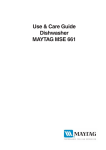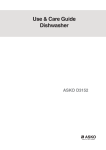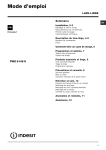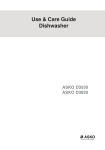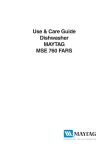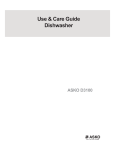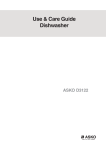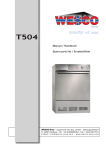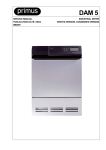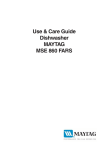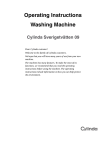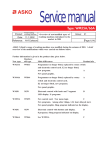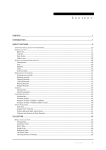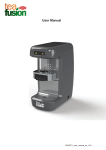Download Asko DW20 Dishwasher Ser Man
Transcript
Service manual Dishwasher Type: DW20.1, DW20.2, DW20.3, DW20.4 Asko Cylinda AB/After Sales Box 344 SE-532 24 Skara Sweden 2 Contents 1. Introduction .............................................................................................................. 5 2. Technical data ........................................................................................................... 7 2.1 Technical information ....................................................................................... 7 2.2 Components and measured values ................................................................... 8 2.3 Connection diagram ....................................................................................... 10 2.4 Functional description of components ............................................................. 11 3. Installation.............................................................................................................. 14 4. Settings ................................................................................................................... 18 4.1 Programme .................................................................................................... 18 4.2 Time display ................................................................................................... 18 4.3 Options .......................................................................................................... 19 5. Service menu .......................................................................................................... 27 5.1 Activation of service menu ............................................................................. 27 5.2 Programme flow description .......................................................................... 29 6. Troubleshooting ...................................................................................................... 31 6.1 Most common faults ....................................................................................... 31 6.2 Fault indication .............................................................................................. 33 6.3 Fault codes ..................................................................................................... 34 7. Tools ....................................................................................................................... 35 7.1 Tools .............................................................................................................. 35 7.2 Special tools ................................................................................................... 35 Register ...................................................................................................................... 36 3 INTRODUCTION 1. Introduction In your hand you are holding ASKO’s Service Manual for the new generation of dishwashers. The dishwashers in the DW20 range are available in four different basic models with the type designations DW20.1, DW20.2, DW20.3 and DW20.4. Presented on the following page are the different panels available for each type, which lets you readily identify the machine type. The different variants have different designations from market to market. The type designation is most important when you need to identify a particular type of machine. You can find this on the machine rating plate positioned on the right-hand side of the inner part of the door. Type designation Item number Year Week Serial number It must be easy to carry out servicing on dishwashers. It is important for you, as a service technician, to benefit from the conditions necessary to enable you to work in an effective and satisfactory fashion. We hope that this Service Manual will be a useful tool in your daily work. Asko Cylinda AB/After Sales Box 344 SE-532 24 Skara Sweden 5 INTRODUCTION DW20.1 DW20.1 is available in two variants, either with none or with two options. Both have four set programmes and operating controls on the front of the panel. DW20.2 DW20.2 is a control unit with a large display on the front of the panel. It has six set programmes and none or three or five options. DW20.3 The buttons are on the top side of the control unit in the DW20.3. The unit has six set programmes and is available in two models - with three or five options. DW20.4 DW20.4 is a control unit with ten set programmes, a number of different options and with a single display (LCD) on the top side of the panel. The DW20.3 and DW20.4 control units are used both for fully integrated and standard models. The other control units are used only on standard models. 6 TECHNICAL DA ATT A 2. Technical data 2.1 Technical information Height: Width: Depth: Weight: Capacity*: Water pressure: Connection: Max connection power: 820 - 870 mm (860 - 870 mm) 596 mm 550 mm 42 kg/45 kg with water softener 12 place settings 0.03–1.0 MPa (0.3–10 kp/cm2) 1-phase, 230 V, 50 Hz 10 A** 1 900 W** *According to standard EN 50242 **See rating plate 7 TECHNICAL DA ATT A 2.2 Components and measured values Indicated resistance values apply at room temperature (ca. 20°C/68°F) Values within ±10% are regarded as normal 8 Item No. Component Measured value Position 8073779 Radio interference suppression filter 680 kohm 8073780,81 Radio interference suppression filter 1 Mohm 8073784 Heating element 1800 W 230 V 30 ohm 8073785 Heating element 1400 W 120 V 12 ohm 8073788 Thermistor 25 kohm 8073801,02 Combined dispenser 230 V 1.3 kohm 8073803,04 Combined dispenser 120 V 0.3 kohm 8073811 Circulation pump 200-240 V 50 HZ 90 ohm 8073812 Circulation pump 200-220 V 60 HZ 56 ohm 8073813 Circulation pump 120 V 60 HZ 22 ohm 8073816 Drain pump 200-240 V 50 HZ, 16 l/m 150 ohm 8073817 Drain pump 200-220 V 60 HZ, 16 l/m 85 ohm 8073818 Drain pump 120V 60 HZ, 16 l/m 25 ohm 8073821 Spray arm divider 200-240 V 50/60 HZ 8,5 kohm 2-3 8073822 Spray arm divider 120 V 60 HZ 2.6 kohm 2-3 8073824 Inlet valve single incl. flow sensor 200-240 V, 4 l/m 3.8 kohm coil 8073825 Inlet valve single incl. flow sensor 120 V, 4 l/m 0.95 kohm ” 8073826 Inlet valve safety incl. flow sensor 200-240 V, 4 l/m 2 kohm ” 8073827 Inlet valve safety incl. flow sensor 120 V, 4 l/m 0.5 kohm ” 8074337 Inlet valve water soft incl. flow sensor 200-240 V, 4 l/m 3.8 kohm ” 8074338 Inlet valve water softener incl. flow sensor 120 V, 4 l/m 0.95 kohm ” 8073830 Halogen lamp 5 W/12 V <10 kohm 8052778 Wax motor 1.1 kohm 8073847 Fan motor 230 V 0.75 kohm 8073848 Fan motor 120 V 0.18 kohm TECHNICAL DA ATT A Item No. Component 8801222 Control unit Compl., DW20.1 EU, Asia, etc. 8801223 Control unit Compl., DW20.1 AU 8801224 Control unit Compl., DW20.1 USA 8801225 Control unit Compl., DW20.2 EU 8801226 Control unit Compl., DW20.2 AU 8801227 Control unit Compl., DW20.2 USA 8801228 Control unit Compl., DW20.3 EU 8801229 Control unit Compl., DW20.3 AU 8801230 Control unit Compl., DW20.3 USA 8801231 Control unit Compl., DW20.4 EU 8801232 Control unit Compl., DW20.4 AU 8801233 Control unit Compl., DW20.4 USA 9 S:\U\Dw20\1_Tryckunderlag\Kopplingsschema\8073809 Circuit diagram DW20.4_c.dft , mall , 2002-06-18 08:34:08 E F A B C EL 6 8 7 WIRES IN ALL MACHINES INTERNAL CONNECTION WIRES IN SOME MACHINES 6 Rev ind Revision CP EL LU TB AP: DRAIN PUMP BB: ILLUM. SWITCH BE: HALOGEN LAMP CP: CIRCULATION PUMP DIV: WATER DIVERTER VALVE EL: HEATING ELEMENT F: FILTER FG: HUMIDITY SENSOR FL: FAN FM: FLOW METER GS: TURBIDITY SENSOR IV: INLET VALVE KD: COMBI DISPENSER LB: DOOR SWITCH LU: DOOR NTC: THERMISTOR SG: SALT SENSOR SV: SALT VALVE TB: MAIN SWITCH TS: PRESSURE SENSOR VAX: VAX ACTUATOR VMG: RINSE AID SENSOR NET: INTERFACE TO HOME NET COMMUNICATION UNIT ÖB: FLOAT SWITCH 7 5 N F L 5 FG 1 AP AP Appd Year Week 1/C D This document must not be copied without our written pemission, and the contents thereof must not be imparted to a third party nor be used for any unauthorized purpose. Contravention will be prosecuted. Asko Cylinda AB EL 3/4 LB 10 4 LB 3/4 KD KD 2 NET 4 Released by Designed by Scale M aterial 9 CP CP IV 3 3 Issby Dept Gen.tol.A ngle 3 IV SV SV 4 SG SG 5 DIV M DIV 2 BE 41 Year W eek 6 BE 7 8 GS 1/C 2 TS 1 23 Material BB FM NTC GS TS FM NTC 2 80 738 09 00 Re v Ind Project Replace KOPPLINGSSCHEMA DW20.1, .2, .3, .4, .C Description(SE ) CIRCUIT DIAGRAM DW20.1, .2, .3, .4, .C Description(ENG) e Dens.Kg /dm 3 Dim ensions,Type, tc. Name of item VAX VAX Gen.tole rance FL FL FG UD 00 ASKOCYLINDA ML 1:1 Pos. Qty Part No. ÖB VMG VMG TB 2 10 1/C 8 1FORMAT A3 1 A B C D E F TECHNICAL DA ATT A 2.3 Connection diagram TECHNICAL DA ATT A 2.4 Functional description of components A description of the function and specification of the different electrical components is given here. Certain components are only included in highly specified machines or on individual markets. Inlet valve/Flow valve Available in single, safety and water softener valve models. A filter which traps particles is located in the valve. Situated after this is a flow restrictor, which maximizes the flow to 4 l/min. The valve opens at water pressures exceeding 0.3 bar and gives full flow at ca. 1 bar. The flow meter is situated on the valve outlet, where it is secured with a clip. Single valve The single valve consists of a draw magnet and a valve seat. Water softener valve The water softener valve consists of two parallelconnected valve seats, each with a draw magnet. One part is used for regeneration of the water softener (salt intake). An additional flow restrictor, which maximizes the flow to 0.5 l/minute, is located in the outlet from the water softener valve. The other part is used for the regular water intake, with the flow sensor connected after it. Circulation pump The circulation pump consists of an asynchronous motor, a pump part and a condenser. Flow sensor The flow sensor is used to regulate the water intake so that the correct water volume is admitted regardless of the water pressure. There is also the possibility of switching the machine over to time-controlled water intake. The flow sensor consists of a rotor containing a magnet and a counterweight, which are caused to rotate by water flowing through. Situated externally on the flow sensor housing is a sensor, a so-called reed switch, of which the contact is closed every time the magnet passes. The number of pulses from the sensor is proportional to the volume of water flowing through. Output signal: 210 pulses/litre Safety valve The safety valve consists of two mutually independent valve seats, which are operated by two draw magnets. The valve seats are connected in series. This provides double reliability. The draw magnets are also electrically connected in series, which means that the magnet’s rated voltage is half the mains voltage (e.g. 120 V valve = 2 x 60 V coils) Spray arm divider Certain machines are equipped with a spray arm divider. The spray arm divider consists of a synchronous motor that via a set of gears rotate a valve-disc. A damper distributes the water from the circulation pump to the upper and lower spray arms in a different quantity and at a different pressure. The motor/gearbox also causes a cam with four different step times to rotate. A contact detects the cam (step time) and provides the control unit with feedback about the current position when setting the desired spray arm status. Note that the spray arms never rotate simultaneously. The following spray arm statuses are encountered: • Upper spray arm half or full pressure • Lower spray arm half or full pressure Depending on the programmeme, items being washed and options, the spray arms will be regulated with a varying interval and spray pressure. Machines with no spray arm divider have a water distributor instead. This directs the water to both spray arms. The spray arms always rotate simultaneously. 11 TECHNICAL DA ATT A Main switch Heating element The heating element is of the through-flow type and is situated between the sump and the suction sleeve of the circulation pump. It consists of a pipe with a heating coil. On one side of the heating element coil is an overheating safety device with a breaking temperature of 97°C and with automatic resetting. On the other side is a fusible cut-out rated at 206°C. Drain pump The drain pump consists of a synchronous motor with an output of ca. 30 W and a pump part. The direction of rotation is random, which makes it partially self-cleaning. Fan The fan evacuates the moist air from the machine during the programme’s drying phase. The fan system consists of a fan motor which drives a double-sided impeller. Dry air is sucked in from the opening on one side of the impeller. Humid air flows in on the other side of the impeller, when a wax motor opens a valve. This takes place with a certain delay. Dry and moist air are mixed in a channel leading to the under part of the opening, where it is discharged. The main switch is a 2-pole unit and switches between phase and neutral. The filter, overflow cut-out, drain pump and inlet valve are not disconnected, however, when the main switch shuts off the power supply. Radio interference suppressor The radio interference suppressor ensures that the machine does not interfere with its environment and protects the machine from external incoming interference. Door switch A microswitch senses when the door has been opened. There is a pause in the programme, and the power supply to certain components (motor, valves, etc.) is shut off. The programme continues from the point at which it was interrupted when the door is closed. Overflow cut-out The overflow cut-out consists of a float which actuates a microswitch. This closes the inlet valve electrically and starts the drain pump. The cut-out function operates regardless of whether the main switch is on or off. Detergent and surfactant dispenser Lighting The detergent and surfactant dispenser is equipped with a draw magnet which, on first actuation, dispenses detergent and, on second actuation, dispenses surfactant. The system is reset when the dishwasher door is opened. Inside the dispenser is an adjustable volume chamber for setting the desired quantity of surfactant. The surfactant level can be checked in an optical sight gauge located on the upper side of the dispenser. Certain models have a sensor for sensing the surfactant level, a so-called reed switch, mounted on the dispenser. This is indicated on the panel. The lighting consists of a 5 W/12 V halogen lamp, which is powered from the control unit via a microswitch. It lights the lamp when the door has been opened to an angle of more than 5 degrees. The lamp is dimmed when it is lit in order to reduce the starting current and to extend the service life of the lamp. There are protective components on the control unit which limit the power supply to the lamp in the event of a shortcircuit, or if a replacement lamp of excessively high power is fitted. The lamp can be replaced from inside the washing compartment. 12 TECHNICAL DA ATT A Wiring Pressure sensor The machine is provided with coded contacts to prevent faulty connection. The wiring conforms to the standard for Rast 2.5 and 5. The pressure sensor is connected to the pressure chamber in the sump. It measures the pressure corresponding to the water level in the machine. In the event of an excessively high water level in the machine (continuously under 5 sec), the drain pump starts and other components are switched off. When right level is reached the programme will continue. Is the level not reached within one minute the programme completes. Water softener The water softener softens incoming water in order to prevent lime scale deposits on items to be washed and the machine. The ion exchanger mass is regenerated by opening the salt valve and admitting salt-saturated water into the ion exchanger during the main wash. The ion exchanger is flushed through at the end of the main wash. The quantity of salt, the interval (number of programmes) between the regenerations and the pre-wash volume are determined by the set water hardness and the programmes that are used. The higher the set water hardness and programme length, the greater the quantity of salt, the more frequent the regeneration and the higher the pre-wash volume. Certain models have a sensor, a so-called reed switch, which senses when the salt has run out. Other models have an optical indicator in the salt filler cover. Turbidity sensor Located on the side of the machine is an antisiphonage device which prevents dirty water from being sucked back into the water mains, for example in the event of a vacuum in the water mains. Machines with an automatic programme (Auto wash, etc.) have a turbidity sensor which senses the turbidity of the water. The sensor consists of an LED and a phototransistor. The wash process water is present between these. The smaller the quantity of light reaching the phototransistor, the more turbid the water. The sensor is calibrated in the automatic programme’s final rinse. At different times during the automatic programme, the turbidity sensor’s output signal provides the basis for how the wash programme will proceed (with/ without prewash, temperature, cycle time, number of rinses, etc.). In the event of a fault in the turbidity sensor, the machine assumes ”high turbidity”, which gives a long cycle time with prewash and with extra rinses, etc. The turbidity sensor is situated on the front edge of the sump. Thermistor Humidity sensor The thermistor is situated on the inner door and checks the water temperature so that the set temperature is reached. If the thermistor is shortcircuited or if it becomes detached from the circuit board, the element is switched off. The humidity sensor is situated in the fan housing. It is of the capacitive type and measures the relative humidity. The humidity sensor measures the ambient humidity before the start of the drying process. The drying process then continues until the humidity sensor senses a level immediately above the ambient humidity. (Min. time 30 minutes, max. time 70 minutes). Airbreak 13 I N S TTA ALLA ATT I O N 3. Installation Recommended position for the dishwasher Built-in installation The dishwasher can be installed as a built-in, fully freestanding or half freestanding machine. 570 20 550 WARNING! Connection to electricity, water and drains must be carried out by a person with competence within the respective area. 820-870 ( 860-870 ) 820-870 ( 860-870 ) 100150 570 600 A. Built-in The dishwasher can be built in under a worktop with a working height of 820 - 870 mm. (860 - 870 mm) = tall tank. The width dimension must be at least 600 mm (see Figure 1). 0 -23 175 50 50-10 5 Figure 1. Freestanding installation B. Freestanding A freestanding machine must be provided with tilt prevention means. This consists of two metal brackets, which are screwed in place according to the illustration (see Figure 2). An alternative to this type of tilt prevention is a counterweight installed directly on the rear of the machine. Slide in the machine so that the metal brackets engage with the rear feet. The machine now cannot tilt if a load is placed on the open door. If the machine is installed as a fully freestanding machine, both side panels and the worktop should be installed. These accessories can be purchased where you purchased the dishwasher. 413 45 5- 47 5 Figure 2. WARNING! A fully stand-alone machine must be provided with tilt prevention/counterweight. C. Half freestanding If you position the machine so that one of the sides is visible, you can install one side panel. 14 600 I N S TTA ALLA ATT I O N Connection to water Connection to drain There must always be a stopcock in the supply line. The stopcock must be positioned above the sink or on the front edge of the sink unit. The inlet pipe has a union with a 1/2” or 3/4” internal thread, depending on the country. When installation is complete, open the stopcock, leave the system under pressure for a time and check that all connections are tight. • Route the drain hose to a connection nipple on the water trap of the sink. Note that the hose must be secured on a level with the under side of the sink, as washing water from the sink can otherwise run down into the dishwasher (see Figure 3). A machine equipped with a flexible cord and a plug must be connected to an earthed electrical socket. Technical data See rating plate on the right-hand side of the door. WARNING! The flexible cord must be disconnected or the electrical socket must be dead when working on the machine! • The drain hose may be extended up to a maximum of 3 m. Any connectors and connecting pipes must have an internal diameter of at least 16 mm. No part of the drain hose may lie higher than 950 mm above the floor (see Figure 3). • The hose must not be taken directly to a floor drain or similar. In this case the hose can function as a siphon which suck water out of the machine. • The hose must always discharge at least 350 mm above the floor (see Figure 3). • Connect the Hose holder. (Min 350 mm - max 950 mm above the floor. Holder hose Max 950 mm Min 350 mm Connection to electricity • Fit the drain hose onto a cone-shaped pipe connection on the water trap of the sink. The cone-shaped pipe must be cut to an internal diameter of at least 16 mm (see Figure 3). Min 16 mm Max 3 m Figure 3. 15 I N S TTA ALLA ATT I O N Adjustment of machine with six feet (stand-alone dishwasher) 1. 2. 3. Adjust the height of the machine with the four steel feet. (see Figure 4) NOTE! The machine must not be inclined by more than 5 mm. Lock the feet with the nuts. After adjusting the steel feet, screw the two rubber feet firmly to the floor. The rubber feet now act as a tilt prevention means. (see Figure 5) Stålfötter Steel Steel feet feet Figure 4. Adjustment of machine with three or four feet 1. 2. 3. 4. 5. 6. 7. Begin by measuring the height from the floor to the lower edge of the worktop. Fit the sliding feet to the machine (see Figure 6). Measure the height from the floor to the top edge of the machine. Adjust all the feet by screwing them clockwise to raise or anticlockwise to lower. Check that the height of the machine corresponds to the height from the floor to the under side of the worktop. Tighten the locking nuts on the rear feet. Slide the machine into place. Adjust the front feet accurately (the machine must not be inclined by more than 5 mm) and tighten the locking nuts. Figure 5. Adjustment of machine with adjustable foot 1. 2. 3. 4. 5. 6. 16 Begin by measuring the height from the floor to the lower edge of the worktop. Fit the sliding feet to the machine (see Figure 6). Measure the height from the floor to the top edge of the machine. Incline the machine forwards slightly and adjust the rear foot roughly by screwing the adjuster screw on the front clockwise to raise or anticlockwise to lower (see Figure 7). Use a broad-bladed screwdriver or a screwdriver with a hexagonal grip. Adjust the front feet by rotating them clockwise to raise or anticlockwise to lower. Check that the height of the machine corresponds to the height from the floor to the under side of the worktop. Figure 6. Figure 7. I N S TTA ALLA ATT I O N 7. 8. Slide the machine into place. Adjust the feet accurately (the machine must not be inclined by more than five mm) and tighten the locking nuts on the front feet. To prevent kinking, pull on the drain hose and connection pipe (see Figure 8). Adjustment of plinth (only for models with a kickplate as an accessory) The machine has two kick-plates. Use the higher plate if the machine will be 850 870 mm high and the plinth depth can be varied between 45 - 105 mm. Use the lower plate if the machine will be 820 - 845 mm high. . Secure the insulating mat supplied to the kick-plate. Figure 8. Adjustment of right plinth depth 1. Move the grey hooks towards one another and pull out the holders as far as required. Push in the hooks so that they lock the holders securely (see Figure 9). 2. Hang the kick-plate on the holders by introducing it into the grooves. 1 2 Figure 9. Fitting fixed kick-plate The machine is delivered with: 1. A height adjustable kick-plate. 2. Two screws. (see Figure 10) Figure 10. Screw the machine in place If the machine is screwed on the sides, cover the screw holes with the plastic plugs supplied. Check after securing that the front feet are in contact with the floor (see Figure 11). Figure 11. 17 I N S TTA ALLA ATT I O N 4. Settings 4.1 Programme Certain programmes are not included in all machines. Intensive wash Prewash (40 °C), prewash (cold), main wash (basic temperature 60°C), pre-wash, two rinses, final rinse (hot-temp. depending on drying selection, with/without fan, etc.), drying. Heavy wash Basic temperature 55°C in main wash, otherwise according to Intensive wash. Lower basket wash Main wash (incl. pre-soak, basic temperature 55°C), rinse (cold), final rinse (hot), drying. Items to be washed are placed only in the lower basket. Most of the process water is directed by the spray arm divider to the lower spray arm. Delicate wash Main wash (incl. pre-soak, basic temperature 50°C), rinse (cold), final rinse (hot), drying. The process water is directed by the spray arm divider with a high proportion of low spray pressure. Quick wash Normal wash Main wash (incl. pre-soak, basic temperature 55°C), pre-wash, rinse, final rinse (hot), drying. In certain markets a cold prewash is added. Main wash (basic temperature 30°C), rinse (cold), final rinse (cold for without drying). Rinsing One final rinse (50°C), drying. Auto wash The washing process is adapted automatically according to the actual load, i.e. with/without prewash, temperature and cycle time in main wash, number of rinses, etc. In machines with a humidity sensor, the drying process is also controlled to give an optimal result. Mixed wash Main wash (incl. pre-soak, basic temperature 55°C), pre-wash, rinse, final rinse (hot), drying. Programme adapted for lightly soiled/fragile items to be washed in the upper basket and heavily soiled/coarse items to be washed in the lower basket. The spray arm divider directs a larger proportion of the water through the lower spray arm, with a high spray pressure in the lower spray arm, and a low pressure in the upper spray arm. Upper basket wash Main wash (including pre-soak, basic temperature 55°C), rinse (cold), final rinse (hot), drying. Items to be washed are placed only in the upper basket. Most of the process water is directed by the spray arm divider to the upper spray arm. 18 Rinsing One rinse (cold). 4.2 Time display DW20.2, DW20.4: For programme selection, the display shows the time taken by the programme on the previous occasion. After starting the programme, the time is counted down in stages of one minute (no conversion while the programme is running). A new time is not stored if a fault has occurred while the programme is running. DW20.2, DW20.3: The start lamp flash if the door is opened during the programme or is open when the programme is started. DW20.1: The programme sequence lamps flash if the door is opened during the programme or is open when the programme is started. SETTINGS 4.3 Options The machine stores the selected settings when the start button is pressed, and these continue to apply until new settings are made. A delayed start and the upper/lower/mixed basket function are not stored. 19 SETTINGS DW20.1 L2 L3 L2 L12 L4 L1 PROGRAM S1 L3 L7 L12 L1 L11 L4 PROGRAM START S2 S3 START L11 S1 STOP L7 S2 S4 L5 L6 L8 STOP L10 L9 Panel type DW20.1, L = LED, S =Push-button Water hardness setting Temperature selection S3 L6 lights when High temperature is selected Drying selection S4 Long (Extra) and Normal drying (Quick wash: Long and Short drying). (L5 lights when long/extra drying is selected) Variant setting If the control unit is replaced, the machine will automatically be in the variant setting menu when the power supply is switched on for the first time. 1. L1 flashes, continue with point 2. If not the L1 flashes then press the programme button (S1) repeatedly until L1 is flashing. 2. Confirm your choice by pressing Start (S2). (The programme then reverts automatically the main menu.) If you wish to access the variant setting menu again: 1. 2. 3. 4. 5. 6. 7. 20 Turn off the main switch (1/0) Wait for at least five seconds Keep the Programme and Start button depressed (S1&S2) Turn on the main switch (1/0) Release the Programme and Start button (S1&S2). Proceed with point 6 within 5 sec! Press Start (S2) three times in a rapid succession Confirm with Start (S2) The programme then reverts automatically to main menu. Activation of setting menu 1. Turn off the main switch (1/0) 2. Wait for at least five seconds 3. Keep the Start button (S2) depressed 4. Turn on the main switch (1/0) 5. Release the Start button (S2) after 5 sec. L7 starts to flash 6. Select desired water hardness with the Programme button (S1) Setting: Water hardness [°dH] (German degrees of hardness) All LEDs are extinguished L1 lit L1-2 lit L1-3 lit L1-4 L1-5 +L11 lit L1-6 +L12 lit 7. 0-5 (incl. machines without water softener) 6-8 9-14 15-19 20-29 30-44 45+ Confirm your choice by pressing Start (S2). The programme returns to the main menu. Total reset To reset the machine to its basic settings. 1. 2. 3. 4. Turn off the main switch (1/0) Keep the Programme button (S1) depressed Turn on the main switch (1/0) Release the Programme button (S1). The machine now resets various settings, but not the water hardness. The machine then reverts automatically to the main menu. SETTINGS DW20.2 S7 Super rinsingAlt. 2 (certain markets) Adds two rinses. L1 L2 L3 L4 L5 Variant setting L6 S1 S2 S3 S4 S5 S6 S7 If the control unit is replaced, the machine will automatically be in the variant setting menu when the power supply is switched on for the first time. 1. Panel type DW20.2, L = LED, S =Push-button, D= Display S3a Washing in both baskets Both-basket washing (basic setting). The machine’s upper and lower baskets are loaded with items to be washed. 2. b Washing in the upper basket Most of the process water is directed by the spray arm divider to the upper spray arm. c Washing in the lower basket Most of the process water is directed by the spray arm divider to the lower spray arm. S4 Temperature 1. 2. 3. 4. 5. S4 lights when High temperature is selected S5 Delayed start 6. Programme start delayed by 1-12 hours S6 Drying selection Long and Normal drying (Quick wash: Long and Short drying). LED lights when long drying is selected 7. 8. Press the Programme button (S1), repeatedly until the desired variant is selected: Display shows 1: Variant Express (S7) also valid for 3 buttons. Display shows 2: Variant with Super rinse option (S7) Confirm your choice by pressing Start (S2). The machine senses the presence of the turbidity and pressure sensors and the spray arm divider. The programme then reverts to the main menu. If you wish access to the variant setting again: Turn off the main switch (1/0) Wait for at least 5 seconds Keep the Programme/Start buttons (S1&S2) depressed Turn on the main switch (1/0) Release the Programme/Start buttons (S1&S2) at once! Proceed with point 6 within 5 sec! Press Start (S2) three times in a rapid succession. Indication 1 or 2 flashes in the display. Select with S1 Confirm with S2 The programme then reverts automatically to main menu. S7 Express Alt. 1 (certain markets) Reduces the main wash temperature by 10°C, lowers the rinse temperature (to 45°C in machines with a fan) and shortens the drying time. For certain markets the Express function is basically activated in Normal wash. 21 SETTINGS Water hardness setting Child lock Activation of setting menu: Activation of setting menu: 1. 2. 3. 4. 5. 6. 1. 2. 3. Turn off the main switch (1/0) Wait for at least 5 seconds Keep the Start button (S2) depressed Turn on the main switch (1/0) Release the Start button (S2) Select desired water hardness with the Programme button (S1) Setting: Display shows: 0 Display shows: 1 Display shows: 2 Display shows: 3 Display shows: 4 Display shows: 5 Display shows: 6 Display shows: 7 Display shows: 8 Display shows: 9 7. Water hardness [°dH] 0-5 (incl. machines without water softener) 6-8 9-11 12-14 15-19 20-24 25-29 30-39 40-49 50+ Confirm your choice by pressing Start (S2). The programme returns to the main menu. Super rinse (only machines with Express; S7) Adds two rinses at all programs, except Auto, Quick and Rinse & Hold Activation of setting menu: 1. 2. 3. 4. 4. 5. 6. 22 Turn off the main switch (1/0) Wait for at least 5 seconds Keep the Express button depressed (S7) Turn on the main switch (1/0) Release the Express button (S7) Select desired status with the Programme button (S1) Display shows 0: Super rinse deactivated Display shows 1: Super rinse activated Confirm your choice by pressing Start (S2). The programme returns to the main menu. 4. 5. 6. 7. Turn off the main switch (1/0) Wait for at least 5 seconds Keep the Temperature and Drying selection buttons depressed (S4 & S6) Turn on the main switch (1/0) Release the Temperature and Drying selection buttons (S4 & S6) Select status with the Programme button (S1) Display shows 0, key extinguished: Child lock deactivated Display shows 1, key lit: Child lock activated Confirm your choice by pressing Start (S2). The programme returns to the main menu. To unlock the child lock temporarily, the Temperature (S4) and Drying selection (S6) buttons must be pressed in simultaneously. The machine can now be operated normally for three minutes. 1. 2. 3. 4. 5. 6. Turn off the main switch (1/0) Wait for at least 5 seconds Keep the Programme and Sart buttons depressed (S1 & S2) Turn on the main switch (1/0) Release the Programme and Start buttons (S1 & S2) Press Start (S2) three times within five seconds Total reset To reset the machine to its basic settings. 1. 2. 3. 4. 5. Turn off the main switch (1/0) Wait for at least 5 seconds Keep the Programme button depressed (S1) Turn on the main switch (1/0) Release the Programme button (S1). The machine now resets various settings, although not the water hardness and intake volume, and senses the presence of the turbidity and pressure sensors and the spray arm divider. The machine then reverts automatically to the main menu. SETTINGS DW20.3 S1 L1 L2 L3 L4 L5 L6 S3 S4 S5 S6 S7 S2 Panel type DW20.3, L = LED, S = Push-button S3a Washing in both baskets Both-basket washing (basic setting). The machine’s upper and lower baskets are loaded with items to be washed. Super rinsing Alt. 2 (certain markets) Adds two rinses. Variant setting b Washing in the upper basket Most of the process water is directed by the spray arm divider to the upper spray arm. c Washing in the lower basket If the control unit is replaced, the machine will automatically be in the variant setting menu when the power supply is switched on for the first time. 1. Press the Programme button (S1, repeatedly until the desired variant is selected): L1 lit: Variant Express option (S7) Also valid for 3 buttons design. L2 lit: Variant Super rinse option (S7) 2. Confirm your choice by pressing Start (S2). Most of the process water is directed by the spray arm divider to the lower spray arm. S4 Temperature selection LED lights when high temperature is selected. S5 Delayed start Programme start delayed by five hours. S6 Drying selection (LED lights when long drying is selected) Long and Normal drying (Quick wash: Long and Short drying). S7 Express Alt. 1 (certain markets) Reduces main wash and rinse temperature by 10°C, and shortens the drying time eight minutes. For certain markets the Express function is basically activated in Normal wash. The machine senses the presence of the turbidity and pressure sensors and the spray arm divider. The programme returns to the main menu. If you wish to access the variant settings menu again: 1. Turn off the main switch (1/0) 2. Wait for at least 5 seconds 3. Keep the Programme/Start buttons (S1&S2) depressed 4. Turn on the main switch (1/0) 5. Release the Programme/Start buttons (S1&S2) at once! Proceed with point 6 within 5 sec! 6. Press Start (S2) three times in a rapid succession. L1 or L2 is flashing 7. Select with S1 8. Confirm with S2 The programme then reverts automatically to main menu. 23 SETTINGS Water hardness setting Child lock Activation of setting menu: Activation of setting menu: 1. 2. 3. 4. 5. 6. 1. 2. 3. Turn off the main switch (1/0) Wait for at least 5 seconds Keep the Start button depressed (S2) Turn on the main switch (1/0) Release the Start button (S2) Select the desired water hardness with the Programme button (S1) 4. 5. 6. Setting: All LEDs extinguished L1 lit L1-2 lit L1-3 lit L1-4 lit L1-5 lit L1-6 lit 7. Water hardness[°dH] 0-5 (incl. machines without a water softener) 6-8 9-14 15-19 20-29 30-44 45+ Confirm your choice by pressing Start (S2). The programme returns to the main menu. Super rinse (only machines with Express; S7) Turn off the main switch (1/0) Wait for at least 5 seconds Keep the Temperature and Drying selection buttons depressed (S4 & S6) Turn on the main switch (1/0) Release the Temperature and Drying selection buttons (S4 & S6) Select the status with the Programme button (S1) L1 extinguished, Child lock deactivated L1 lit, Child lock activated 7. Confirm your choice by pressing Start (S2). The programme returns to the main menu. To unlock the child lock temporarily, the Temperature (S4) and Drying selection (S6) buttons must be pressed simultaneously. The machine can now be operated normally for three minutes. Activation of setting menu: Total reset 1. 2. 3. 4. 5. 6. 1. 2. 3. 4. 5. 7. 24 Turn off the main switch (1/0) Wait for at least 5 seconds Keep the Express button depressed (S7) Turn on the main switch (1/0) Release the Express button (S7) Select the desired status with the Programme button (S1) L1 extinguished: Super rinse deactivated L1 lit: Super rinse activated Confirm your choice by pressing Start (S2). The programme returns to the main menu. To reset the machine to its basic settings. Turn off the main switch (1/0) Wait for at least 5 seconds Keep the Programme button depressed (S1) Turn on the main switch (1/0) Release the Programme button (S1). The machine now resets various settings, although not the water hardness and intake volume, and senses the presence of the turbidity and pressure sensors and the spray arm divider. The machine then reverts automatically to the main menu. SETTINGS DW20.4 L8 S3 L9 S4 S1 S2 L1 L2 L3 L4 L5 L6 L7 Panel type DW20.4, L = LED, S = Push-button Variant 1: S3 = Set, S4 = Menu Variant 2: S3 = Temperature S4 = Drying Express Heavy, Normal, Mixed, Upper basket, Lower basket wash: cold, 30, 40, 50, 55, 60, 70, 75°C Delicate and Quick wash: Cold, 30, 40, 50, 55, 60°C Variant 1 Temperature selection Reduces main wash and rinse temperature 10°C, l and shortens the drying time eight minutes For certain markets the Express function is basically activated in Normal wash. Variant 2 Super rinsing Drying selection Adds two rinses. Short, Normal and Long drying. Cooling Loaded baskets Most of the process water is directed by the spray arm divider to the upper spray arm. Lower basket loaded Variant 1 + Variant 2 Upper basket loaded 30 minutes’ fan time are added before the end of the programme to cool down washed items. Most of the process water is directed by the spray arm divider to the lower spray arm. Baskets combined loaded The spray arm divider directs a larger proportion of water through the lower spray arm (high spray pressure lower spray arm). Delayed start Variant 1 Variant 1 Both-basket washing (basic setting). The machine’s upper and lower baskets are loaded with items to be washed. Access to Special settings Menu 1. 2. 3. 4. 5. 6. Turn off the main switch (1/0). Wait for at least 5 seconds Keep (S3) depressed. Turn on the main switch (1/0). Release (S3) Select status with (S3). Proceed with (S4). a) Language: English, Swedish, Norwegian, etc. b) Child lock: on/off. c) Acoustic signal volume at end of programme: 0 (=off), 1, 2…9. Alt 2. Machines with Menu/Set buttons Turn on the Main Switch, step forward with the Menu (S4) until Special Settings menu appear. Follow point 6. above Programme start delayed by 0.5-24 hours 25 SETTINGS Setting: Display shows: 0 without Display shows: 1 Display shows: 2 Display shows: 3 Display shows: 4 Display shows: 5 Display shows: 6 Display shows: 7 Display shows: 8 Display shows: 9 7. Water hardness [°dH] 0-5 (incl. machines water softener) 6-8 9-11 12-14 15-19 20-24 25-29 30-39 40-49 50+ d) Temperature display in °C/°F. e) Add programmes. Select desired programmes with the Programme button (S1). Confirm your choice with Temperature select/Set (S3). A maximum of 10 programmes can be active simultaneously. f) Delete programmes. Select desired programmes with the Programme button (S1). Confirm your choice with Temperature select/Set (S3). g) Machine information. Water consumption for most recent programmes run, number of programmes run. Toggle with S3. Press (S4) or (S2). The programme stores the settings and returns to the main menu. Demo mode Enter by pressing S4 and then turn the power On (S1) or both at the same time Scrolling arguments will appear : “Turbo Drying ...Super Cleaning System...Auto Wash...Flexi Racks...Power Zone...8 Steel......Turbo Drying... Exit by turning power Off (S1). 26 Variant setting If the control unit is replaced, the machine will automatically be in the variant setting menu when the power supply is switched on for the first time. 1. Press the Programme button (S1, repeatedly until the desired variant is selected): Variant 1: Variant with Menu/Set Variant 2: Variant with Temperature / Drying selection. 2. Confirm your choice by pressing Start (S2), or Drying selection/Menu S4). (The machine senses the presence of the turbidity, pressure and humidity sensors and the spray arm divider. The programme reverts to the main menu.) If you wish to access the variant setting menu again: 1. Turn off the main switch (1/0). 2. Wait for at least 5 seconds 3. Keep Programme and Start depressed. (S1 / S2) 4. Turn on the main switch (1/0). 5. Release Programme and Start buttons (S1 / S2) at once! Proceed with point 6 within 5 sec! 6. Press Start (S2) 3 times in a rapid succession 7. Press the Programme button (S1) repeatedly until desired variant is selected. 8. Press Start (S2) to confirm. The programme then reverts automatically to main menu. Total reset To reset the machine to its basic settings. 1. Turn off the main switch (1/0) 2. Wait for at least 5 seconds 3. Keep the Programme button depressed (S1) 4. Turn on the main switch (1/0) 5. Release the Programme button (S1). The machine now resets various settings, although not the water hardness and intake volume, and senses the presence of the turbidity, pressure and humidity sensors and the spray arm divider. The machine then reverts automatically to the main menu. SERVICE MENU 5. Service menu 5.1 Activation of service menu DW20.1 (only water intake setting) 1. 2. 3. 4. 5. Turn off the main switch (1/0) Wait for at least 5 seconds Keep the Programme and Start buttons depressed (S1 & S2) Turn on the main switch (1/0) Release the Programme and Start buttons (S1 & S2) L7 flashes The water intake can now be adjusted by pressing S1 once again. L7 is flashing continuously during the operation. L1 extinguished: Volume-controlled water intake (regulated via the flow sensor) L1 lit: Time-controlled water intake Confirm your choice by pressing Start (S2). The programme returns to the main menu. DW20.2 1. 2. 3. 4. 5. Turn off the main switch (1/0) Wait for at least 5 seconds Keep the Programme and Start buttons depressed (S1 & S2) Turn on the main switch (1/0) Release the Programme and Start buttons (S1 & S2) at once! The display lights up after 5 seconds. The most recent fault to occur is indicated as F1, F2 and so on on the display Press the Programme button (S1) and index through the following components: 1. Inlet valve 2. Salt valve (only machines with water softener) 3. Detergent and surfactant dispenser 4. Circulation pump 5. Heating element and circulation pump (Max 75°C) 6. Fan 7. Drain pump The water intake can be adjusted by keeping the Programme button depressed until ”1” in the display disappears. Press the Programme button and index through the following: Display shows 0: Normal water intake volume Display shows 1: Water intake volume is reduced by 15 % Display shows 2: Water intake volume is reduced by 10 % Display shows 3: Water intake volume is reduced by 5 % Display shows 4: Time-controlled water intake Display shows 5: Water intake volume is increased by 5 % Display shows 6: Water intake volume is increased by 10 % Display shows 7: Water intake volume is increased by 15 % Confirm your choice by pressing Start (S2). The programme returns to the main menu. DW20.3 1. 2. 3. Turn off the main switch (1/0) Wait for at least 5 seconds Keep the Programme and Start buttons depressed (S1 & S2) 4. Turn on the main switch (1/0) 5. Release the Programme and Start buttons (S1 & S2) The most recent fault is indicated as L1-L6. Press the Programme button (S1) and index through the following components. 1. Inlet valve 2. Salt valve (only machines with water softener) 3. Detergent and surfactant dispenser 4. Circulation pump 5. Heating element and circulation pump (Max 75°C) 6. Fan 7. Drain pump 27 SERVICE MENU Keep the Programme button depressed for three seconds to adjust the water intake. Press the Programme button and index through the following: L1-L6 extinguished: Normal water intake volume L1 lit: Water intake volume is reduced by 10 % L2 lit: Water intake volume is reduced by 5 % L3 lit: Time-controlled water intake L4 lit: Water intake volume is increased by 5 % L5 lit: Water intake volume is increased by 10 % L6 lit: Water intake volume is increased by 15 % Confirm your choice by pressing Start (S2). The programme returns to the main menu. DW20.4 1. 2. 3. 4. 5. Turn off the main switch (1/0) Wait for at least 5 seconds Keep the Temperature/Set and Drying/ Menu buttons depressed (S3 & S4) Turn on the main switch (1/0) Release the Temperature/Set and Drying/ Menu buttons (S3 & S4) Press Temperature/Set (S3) for information about: Date code (year/week) and serial number Control unit date code Software version Most recent fault Next most recent fault (if different from the most recent fault) Third most recent fault °C Display °C Display 0 32 40 111 5 40 45 123 10 49 50 134 15 60 55 146 20 71 60 156 25 80 65 167 30 90 70 177 35 101 75 188 The table shows the temperature and equivalent display code 28 (if different from the two most recent faults) Press Drying/Menu (S4) to access component diagnostics. Press Temperature/Set (S3) to activate the following components: 1. Inlet valve (display shows water intake volume) 2. Salt valve (only machines with water softener) 3. Detergent and surfactant dispenser 4. Circulation pump (display shows turbidity in Volts) 5. Heating element and circulation pump (Max 75°C) (Display shows temperature, see table) 6. Fan (display shows humidity sensor value) 7. Drain pump (display shows pressure sensor reading; 0.5-3.5 VDC) Press Drying/Menu (S4) to access water intake setting Press Temperature/Set (S3) to adjust the water intake. Display 0: Normal water intake volume Display –15 %: Water intake volume is reduced by 15 % Display –10 %: Water intake volume is reduced by 10 % Display –5 %: Water intake volume is reduced by 5% Display Time: Time-controlled water intake Display +5 %: Water intake volume is increased by 5 % Display +10 %: Water intake volume is increased by 10 % Display +15 %: Water intake volume is increased by 15 % Press Drying/Menu (S4) to access LCD contrast setting. Press Temperature/Set (S3 repeatedly) to adjust the contrast 0, +1, +2, +3, -1, -2, -3. Press Start (S2) to store the setting of the water intake volume and LCD contrast. The programme returns to the main menu. SERVICE MENU Programme flow description.2 Programme flow description Illustrated below is a normal programme (for EU ) and the sequence in which the various components arc connected. Normal wash Component Commentary Drain pump 25 sec Inlet valve 605 pulse*, 47 sec, 3.1 lit*** Main wash 545 pulse* 43 sec, 2.8 lit** Circulation pump 30 sec Upper arm high pressure ** Pause 1 sec Circulation pump 60 sec Upper arm high pressure ** Pause 1 sec Circulation pump 120 sec Upper arm high pressure ** Pause 1 sec Circulation pump, Heater 32°C Circulation pump 5 min Pause 3 sec Filter cleaning Circulation pump 2 min Upper arm high pressure. Inlet valve, Circulation pump 75 pulse*, 6 sec, 0.4 lit Circulation pump, Combined dispenser 3 sec Circulation pump 3 min Circulation pump, Heater 40°C Circulation pump 3 min Circulation pump, Heater 55°C Circulation pump 39 min Circulation pump 1 min Upper arm high pressure Drain pump 2 sec SCS stage Circulation pump 20 sec SCS stage Upper arm high pressure** Drain pump 25 sec Temperature stop ** Temperature stop ** 29 SERVICE MENU Cooling down (not DW20.1) Machines with softener : Cool down step is NOT performed during regeneration. Drain pump 5 sec Inlet valve 24 sec Circulation pump 60 sec Drain pump 25 sec Pre-wash Inlet valve 170 pulse* , 14 sec, 0.9 lit Circulation pump 20 sec Drain pump 25 sec Lower arm low pressure ** 1st. Rinse Inlet valve 605 pulse*, 47 sec, 3.1 lit*** 545 pulse* 43 sec, 2.8 lit** Circulation pump 9 min Circulation pump 60 sec Drain pump 2 sec SCS stage Circulation pump 20 sec SCS stage Upper arm high pressure Drain pump 25 sec Upper arm high pressure ** ** Final rinse Inlet valve 605 pulse*, 47 sec, 3.1 lit*** 545 pulse* 43 sec, 2.8 lit** Circulation pump 60 sec Circulation pump, Heater 60°C Circulation pump, Combined dispenser 60 sec Circulation pump 4 min Circulation pump 50 sec Pause 60 sec Drain pump 25 sec Drying Fan 48 min Temperature stop Upper arm high pressure ** * pulse = number of pulses from the flow sensor to obtain the given quantity of water ** 30 *** applicable to a machine with spray arm dividers. In stage (with an additional circulation pump) where no spray arm divider status is indicated, sequential 30 seconds lower arm low pressure, 30 seconds lower arm high pressure, 30 seconds upper arm low pressure, 30 seconds upper arm high pressure are intended. without Spray arm dividers. TROUBLESHOOTING 6. Troubleshooting If there are problems with poor washing results, you must observe the following rules in the first instance: • Use a suitable programme, such as Normal programme 55°C/60°C for normally soiled items. Australia: 45°C/50°C • If more heavily soiled items are to be washed, e.g. saucepans or gratin dishes, select a stronger programme, such as Heavy wash or Intensive wash. • It is important to use a suitable detergent, preferably one which has produced good results in tests. • Is the water tap open? If you have answered “YES” to the above questions, and if the machine appears to be without a power supply, you should first check that a power supply is present as far as the main switch and as far as the control unit. If the machine indicates that something is wrong, e.g. “Open door” even though the door is closed, check the door switch. If the machine indicates “Overfilling”, check the overfilling system (microswitch, hoses, etc.) Water remains in the machine • You should not buy a bulk pack, because detergent is a perishable product. The detergent dose must also conform to the recommendations on the pack. Above all, avoid overdosing. • In machines fitted with a water softener, set the dispenser for soft water. • The spray arms must not be obstructed and they must rotate at the correct speed (12 25 r/min). Make sure that the machine takes in the correct quantity of water; see the user handbook. 6.1 Most common faults • Is there a blockage in the drain hose? Check the connection at the union with the building’s drains. • Is there a kink in the drain hose? • Are the filters blocked? • Is the drain pump blocked? • Is the gauge block on the left in the sump next to the drain pump incorrectly seated? If you have answered “NO” to the above questions, first check that the drain pump has a power supply and that it is working. The pump must be replaced if it is faulty. If there is no power supply to the pump, check the output from the control unit. Replace the control unit if it is defective. If the dishwasher does not work, you should first check whether this may be due to a simple fault which the customer himself can correct. Identify the fault with the help of the following questions. The dishwasher is not clean Machine will not start • Are the spray arms able to move freely? • Are the holes in the spray arms free from dirt? • Is the detergent being dispensed correctly? Check that you are dispensing according to the hardness of the water. • Are the fuses intact? • Is the machine connected to the mains? • Is the fine filter securely attached? • Is the door properly closed? • Are you using the correct wash programme? 31 TROUBLESHOOTING • Is the machine correctly loaded? If you have answered “YES” to the above questions, you should check the following: that the machine has the correct quantity of water, that the spray arms are moving in the right direction and are rotating at the correct speed (minimum 12 r/min), that the circulation pump is working as intended, that the spray arm divider is working as intended and that the machine empties the water properly (no residual water present before refilling). Cloudiness or stains on washed items • Is the lid on the water softener screwed securely in place? • Is the rinse aid dispenser correctly set? • Is the water softener correctly set? • Is there salt in the salt container? • Are you using the correct type of salt? • Is the temperature correctly set? If you have answered “YES” to the above questions, you should check the following: spray arms, circulation pump, element, combined dispenser, spray arm divider. If the machine is equipped with a water softener, the inlet valve for the water softener, the airbreak and the function of the water softeners must also be checked. Does the machine stop at the beginning of the wash programme? • Is the water tap fully open? • Is the filter at the screwed nipple of the supply hose clean? If you have answered “YES” to the above questions, you should check the inlet valve + float microswitch. 32 TROUBLESHOOTING 6.2 Fault indication DW20.2 DW20.1 L2 L3 L12 L7 L1 L2 L4 L1 S2 L1 S2 S3 S4 S5 S6 S7 L7 L4 PROGRAM START L11 S1 L8 STOP S2 S4 L10 L5 L6 L6 L3 L12 S3 L5 STOP S1 L2 L4 S1 START L11 PROGRAM L3 L9 DW20.3 S1 L1 L2 L3 L4 L5 S3 L6 S4 S5 S6 S7 S2 DW20.4 L8 S3 L9 S4 S1 S2 L1 L2 L3 L4 L5 L6 L7 L - LED, S - Push-button, F - Fault code on the display 33 TROUBLESHOOTING 6.3 Fault codes LED L12/Fault code F6, Pressure sensor fault In the fault codes below, “L ” denotes LED and “F” denotes fault code on the display. Output signal > 4.8V. The programme continues. Indication only in the service menu. Check: Pressure sensor, control unit and wiring. LED L1/Fault code F1, Temperature stop fault (not DW20.1) The temperature rise is less than 5°C in ten minutes. The programme exits from the heating stage and continues in the process. Indication only in the service menu. Check: Element, thermistor, water level, circulation pump and control unit, wiring. LED L2/Fault code F2, Overfilling Too much water in the machine (pressure sensor) or float activated. If the water has not been evacuated within 60 seconds, the programme will be interrupted (drain pump activated). Check: Drain pump (blockage in hoses), flow sensor, inlet valve, leakage, wiring. LED L3/Fault code F3, Thermistor fault Interruption or >80°C. The programme exits from the heating stage and continues in the process. Indication only in the service menu. Check: Thermistor, control unit. LED L4/Fault code F4, Water intake fault < 80 pulses within 60 seconds or correct number of pulses is not achieved within 255 seconds. Programme interrupted. Check: Water supply, flow sensor, inlet valve, wiring. LED L5/Fault code F5, Valve leakage > 80 pulses detected when the inlet valve is deactivated. Certain models attempt to remedy the leak first. Any programme in progress is interrupted (drain pump activated). Check: Leakage through inlet valve, flow sensor. LED L1+L2/Fault code F7, Pumping out fault (machines with pressure sensor) Water not evacuated after 120 seconds’ pumping out. Programme interrupted. Check: Drain pump, hoses, installation of drain hose, control unit and wiring. LED L1+L3/Fault code F8, Blocked filter The pressure sensor senses excessively low pressure during the final rinse. Indication after end of programme. Check: Filter, sump (pressure chamber), pressure sensor. LED L1+L4/Fault code F9, Circulation fault The pressure sensor senses excessively low pressure (e.g. no water in the machine) or excessively high pressure (e.g. the circulation pump is defective). The programme exits from the heating stage and continues in the process. Indication only in the service menu. Check: Circulation pump, filter, water level, pressure chamber and pressure sensor. LED L1+L5/Fault code FA, Turbidity sensor fault Indication only in the service menu. The machine assumes high turbidity for “choice of route” in the automatic programme. Check: Water quality, filter, turbidity sensor, drain system. LED L1+L6/Fault code FB, Spray arm divider fault Position contact is continuously closed or open. The programme proceeds. Indication only in the service menu. Check: Spray arm divider (function of gearbox, contacts and wiring). LED L7/Fault code, Door open LED L7/Fault code, Close door 34 SERVICE 7. Tools 7.1 Tools The following tools are used for servicing dishwasher model DW20: Torx T25 T20 T10 Ring spanner 10 mm Box spanner 10 mm 7.2 SpecialTools 8801127 UniversalTools, dishwasher 7281370 Hose clip pliers, Oetiker 35 Register A N adjustable foot 16 Airbreak 13 Auto wash 18 Normal wash 18 B Blocked filter 34 Options 19 Overfilling 34 Overflow cut-out 12 C P Circulation fault 34 Circulation pump 11 Connection diagram 10 Connection to electricity 15 Connection to water 15 Pressure sensor 13 Pressure sensor fault 34 Programme 18 Programme flow description 29 Pumping out fault 34 D Q Delicate wash 18 Detergent and surfactant dispenser 12 Drain pump 12 Quick wash 18 E Radio interference suppressor 12 Energy marking 7 O R S Fan 12 Fault codes 34 Flow sensor 11 Flow valve 11 Safety valve 11 Screw the machine in place 17 Settings 18 Single valve 11 Spray arm divider 11 Spray arm divider fault 34 H T Heavy wash 18 Heating element 12 Technical information 7 Temperature stop fault 34 Thermistor 13 Thermistor fault 34 Time display 18 Tools 35 Troubleshooting 31 Turbidity sensor 13 Turbidity sensor fault 34 F I Inlet valve 11 Installation 14 Intensive wash 18 L Lighting 12 Lower basket wash 18 M Main switch 12 Mixed wash 18 36 U Upper basket wash 18 V Valve leakage 34 Variant setting DW20.1 Variant setting DW20.2 Variant setting DW20.3 Variant setting DW20.4 20 21 23 26 W Water hardness setting DW20.1 Water hardness setting DW20.2 Water hardness setting DW20.3 Water hardness setting DW20.4 Water intake fault 34 Water softener 13 Wiring 13 20 21 23 26 37 Notes 38 39 Art. nr 80 755 33 rev 03









































